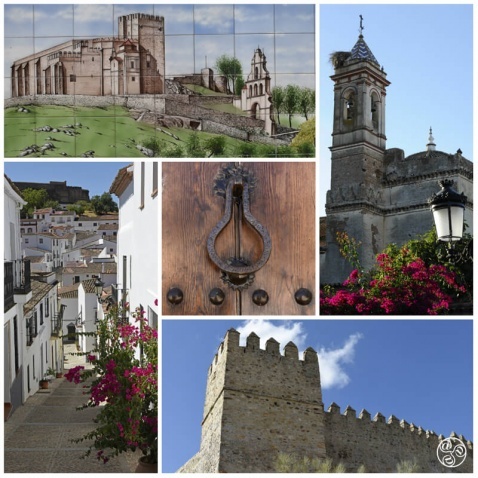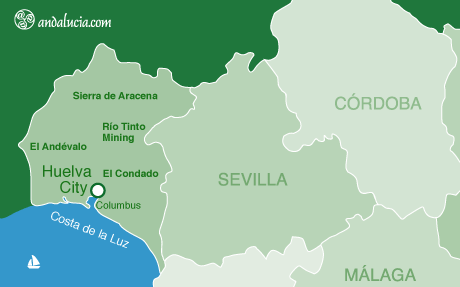
Huelva villages clockwise: Aracena, Cala, Santa Olalla, Almonaster, Cañaveral de León © Michelle Chaplow |
|
Highlights of Villages & Small Towns of huelva province
By Jo Williams
Northern Huelva
Part of the rugged Sierra Morena mountain range, the Sierra de Aracena y Picos de Aroche is a protected natural park of extensive woodland dotted with small whitewashed villages.
The rolling hills have a network of footpaths, which make it excellent walking and horseriding country. In the spring, the area is awash with wildflowers, while in the autumn the landscape is splashed with bright changing colours of the trees.
The area's main town, Aracena, has a distinctive hilltop ruined fortress and a Knights' Templar church. Deep underground in the hillside are some spectacular limestone caves, the Gruta de las Maravillas.
The Sierra is home to the renowned cured ham delicacy, jamón ibérico. This comes from the black Iberian pigs that feed on acorns underneath the holm oak trees that colonise the Sierra. The ham is produced throughout the area, but the biggest producer is based in Jabugo, a village whose name has become synonymous with jamón ibérico.
Autumn is the best time to visit the Sierra for its other famed gastronomic treat, the wild mushroom. The Sierra also is well known for its sweet chestnuts, which you can sample when they are harvested in the autumn. The area has many chestnut trees, which give their name to the village of Castaño. This beautiful village has some of the Sierra's oldest and best-preserved houses, clustered around a tiny square.
Many places have hilltop monuments including Cortegana, with its impressive medieval castle perched high above the town and one of the best views of the Sierra.
Almonaster la Real is a charming village situated below a 10th-century former mosque, which has an arched interior reminiscent of the mezquita in Cordoba.
Aroche is set in a dramatic position on a hilltop with its bullring situated, strangely, within its castle's walls.
Towering above the pretty village of Alájar is the Peña de Arias Montano, a clifftop hermitage dedicated to Alájar's patron saint, Nuestra Señora de los Angeles and the site of a well-known annual pilgrimage in September.
The small village of Zufre is tucked away up on a hill. It has the best square in the Sierra, with attractive tiled benches, lovely gardens and stunning views over the surrounding countryside.
Castaño del Robledo is a village in the Sierra which has remained largely unchanged for centuries. It boasts an impressive church and produces half of Huelva province's chestnut output.
Higuera de la Sierra has a famous Three Kings procession, when everyone in the town takes part in playing out Bible scenes. It is the only one of its kind in Spain, and is also one of the oldest.
Corteconcepcion has a spectacular hilltop bullring, as well as superb local ham and views over the Aracena reservoir.
Puerto Moral is a hill town known for its picturesque location next to the Aracena reservoir, a great place for fishing, watersports, swimming and walks.
Los Marines, just outside Aracena, is famous for its chestnut trees and its many fiestas. Santa Ana la Real also has festivals aplenty, but take your umbrella - it is known for the abundance of its rainfall.
Further south in the foothills of the Sierra are the mines of Río Tinto, which have been exploited for five thousand years for silver, iron and copper. Today, you can find out about the area's fascinating history at the Rio Tinto Mining Park in the town of Las Minas de Rio Tinto, with its museum, mine visit and train rides.
The town of Nerva is located just south of Minas de Rio Tinto, and shares its mining heritage.
Southern Huelva
The Huelva section of the Costa de la Luz has many resorts that have wide, sandy beaches backed by pine woods and nature reserves of marshland and dunes.
Ayamonte is a border town with a Portuguese feel about its streets. The nearest beach is the newly built Isla Canela resort. East from Isla Canela, across an area of marshland known as the Paraje Natural Marismas de Isla Cristina, worth a visit for a spot of birdwatching, is Isla Cristina. This resort, with an impressive choice of great beaches and a busy fishing port, is popular with Sevillanos in summer.
Ten kilometres east is the more low-key resort of La Antilla. This is the beach for the village of Lepe, the strawberry growing capital of Europe. La Antilla beach on the eastern edge merges into the spit of El Rompido, which has virtually deserted beaches and sand dunes. From the spit across the Río Piedras estuary are views to the small fishing village of El Rompido.
Punta Umbría is the largest resort on the Huelva Costa de la Luz and in summer is full of beachgoers enjoying its numerous lively bars and restaurants. If you want to get away from the crowds, visit the Paraje Natural Marismas del Odiel, a large wetland reserve full of birdlife that borders the northern edge of Punta Umbría.
East of Huelva is the small resort of Mazagón and its bigger neighbour, Matalascañas. Between these two is one of best beaches in Andalucía, the Playa de Castilla, backed by fossilised dunes and pine woods.
Matalascañas is the nearest village to the entry point of the enormous Parque Nacional de Doñana. Eighteen kilometres north of Matalascañas is the curious Wild West hamlet of El Rocío, scene of a seething mass of pilgrims at Pentecost for the village's renowned Rocío Pilgrimage.
